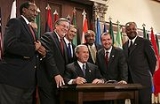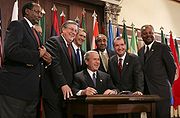
African Growth and Opportunity Act
Encyclopedia

Sub-Saharan Africa
Sub-Saharan Africa as a geographical term refers to the area of the African continent which lies south of the Sahara. A political definition of Sub-Saharan Africa, instead, covers all African countries which are fully or partially located south of the Sahara...
and to improve economic relations between the United States
United States
The United States of America is a federal constitutional republic comprising fifty states and a federal district...
and the region. Rosa Whitaker
Rosa Whitaker
Rosa Whitaker is the CEO and President of the Whitaker Group, a Washington, D.C.-based consultancy specializing in trade and investment in Africa....
, who served as the first ever Assistant U.S. Trade Representative (USTR) for Africa in the administrations of Presidents George W. Bush and William J. Clinton took the final lead in developing and implementing the African Growth and Opportunity Act (AGOA) following nearly a decade of leadership on the part of activists such as Paul Speck at Environmental and Energy Institute, and lawmakers, including Congressman Jim McDermott (a former Foreign Service medical officer based in Zaire) and Senator John Kerry, both senior lawmakers in the area of international trade.
AGOA was initially signed by President Clinton into law in May 2000.
Eligibility
The legislation authorized the President of the United StatesPresident of the United States
The President of the United States of America is the head of state and head of government of the United States. The president leads the executive branch of the federal government and is the commander-in-chief of the United States Armed Forces....
to determine which sub-Saharan African countries would be eligible for AGOA on an annual basis. The eligibility criteria was to improve labor rights and movement toward a market-based economy. Each year, the President evaluates the sub-Saharan African countries and determines which countries should remain eligible. , there are 41 AGOA-eligible countries.
Additional rules of origin are applied to apparel. Having AGOA eligibility does not imply automatic eligibility for a "Wearing Apparel" provision. To export apparel and certain textile to the United States under the AGOA duty-free, an eligible country must have implemented a "Visa System" that satisfies American authorities and proves compliance with the AGOA rules about origin.
Benefits, results and criticism
AGOA provides trade preferenceTrade Preference
A Trade Preference is when one country prefers buying goods from some other country more than it would from other countries. It grants special support to one country over another. It is the opposite of a Trade Prohibition.-See also:*Trade Mandate...
s for quota and duty-free entry into the United States for certain goods, expanding the benefits under the Generalized System of Preferences
Generalized System of Preferences
The Generalized System of Preferences, or GSP, is a formal system of exemption from the more general rules of the World Trade Organization ,...
(GSP) program. Notably, AGOA expanded market access for textile
Textile
A textile or cloth is a flexible woven material consisting of a network of natural or artificial fibres often referred to as thread or yarn. Yarn is produced by spinning raw fibres of wool, flax, cotton, or other material to produce long strands...
and apparel goods into the United States for eligible countries, though many other goods are also included. This resulted in the growth of an apparel industry in southern Africa, and created hundreds of thousands of jobs. However, the dismantling of the Multi Fibre Agreement's world quota regime for textile and apparel trade in January 2005 reversed some of the gains made in the African textile industry due to increased competition from developing nations outside of Africa, particularly China
China
Chinese civilization may refer to:* China for more general discussion of the country.* Chinese culture* Greater China, the transnational community of ethnic Chinese.* History of China* Sinosphere, the area historically affected by Chinese culture...
. Some factories shut down in Lesotho
Lesotho
Lesotho , officially the Kingdom of Lesotho, is a landlocked country and enclave, surrounded by the Republic of South Africa. It is just over in size with a population of approximately 2,067,000. Its capital and largest city is Maseru. Lesotho is a member of the Commonwealth of Nations. The name...
, where most of the growth occurred. Orders from African manufacturers stabilised somewhat after the imposition of certain safeguard measures by U.S. authorities, but Africa's share of the U.S. market was still reduced after the phaseout.
AGOA has resulted in limited successes in some countries. In addition to growth in the textile and apparel industry, some AGOA countries have begun to export new products to the United States, such as cut flowers, horticultural products, automotives and steel. While Nigeria and Angola are the largest exporters under AGOA, South Africa's have been the most diverse and unlike the former are not mainly concentrated in the energy sector. To some countries, including Lesotho
Lesotho
Lesotho , officially the Kingdom of Lesotho, is a landlocked country and enclave, surrounded by the Republic of South Africa. It is just over in size with a population of approximately 2,067,000. Its capital and largest city is Maseru. Lesotho is a member of the Commonwealth of Nations. The name...
, Swaziland
Swaziland
Swaziland, officially the Kingdom of Swaziland , and sometimes called Ngwane or Swatini, is a landlocked country in Southern Africa, bordered to the north, south and west by South Africa, and to the east by Mozambique...
, Kenya
Kenya
Kenya , officially known as the Republic of Kenya, is a country in East Africa that lies on the equator, with the Indian Ocean to its south-east...
and Madagascar
Madagascar
The Republic of Madagascar is an island country located in the Indian Ocean off the southeastern coast of Africa...
, AGOA remains of critical importance. Agricultural products is a promising area for AGOA trade, however much work needs to be done to assist African countries in meeting U.S. sanitary and phytosanitary standards. The U.S. government is providing technical assistance to AGOA eligible countries to help them benefit from the legislation, through the U.S. Agency for International Development (USAID) and other agencies. The U.S. government has established three regional trade hubs in Africa for this purpose, in Accra
Accra
Accra is the capital and largest city of Ghana, with an urban population of 1,658,937 according to the 2000 census. Accra is also the capital of the Greater Accra Region and of the Accra Metropolitan District, with which it is coterminous...
, Ghana
Ghana
Ghana , officially the Republic of Ghana, is a country located in West Africa. It is bordered by Côte d'Ivoire to the west, Burkina Faso to the north, Togo to the east, and the Gulf of Guinea to the south...
; Gaborone
Gaborone
' is the capital and largest city of Botswana with a population of 191,776 based on a 2006 survey, about 10% of the total population of Botswana....
, Botswana
Botswana
Botswana, officially the Republic of Botswana , is a landlocked country located in Southern Africa. The citizens are referred to as "Batswana" . Formerly the British protectorate of Bechuanaland, Botswana adopted its new name after becoming independent within the Commonwealth on 30 September 1966...
; and Nairobi
Nairobi
Nairobi is the capital and largest city of Kenya. The city and its surrounding area also forms the Nairobi County. The name "Nairobi" comes from the Maasai phrase Enkare Nyirobi, which translates to "the place of cool waters". However, it is popularly known as the "Green City in the Sun" and is...
, Kenya
Kenya
Kenya , officially known as the Republic of Kenya, is a country in East Africa that lies on the equator, with the Indian Ocean to its south-east...
.
Initially, AGOA was set to expire in 2008, but the United States Congress
United States Congress
The United States Congress is the bicameral legislature of the federal government of the United States, consisting of the Senate and the House of Representatives. The Congress meets in the United States Capitol in Washington, D.C....
passed the AGOA Acceleration Act of 2004, which extended the legislation to 2015. The Act's apparel special provision, which permits lesser-developed countries to use foreign fabric for their garment exports, was to expire in September 2007. However, legislation passed by Congress in December 2006 extended it through 2012.
Every year an AGOA Forum is held, which brings together government leaders and private sector stakeholders from Africa and the United States. The Forum is held in Washington every other year, and in an AGOA eligible African country in the other years. So far, the Forum has been held four times in Washington, and once in Mauritius, Senegal, Ghana, Kenya (2009) and Zambia (2011).
Some allege that AGOA is in contradiction with WTO rules. Furthermore, it is seen as a one-sided agreement as there was little African involvement in its preparation. Others claim AGOA encourages fraud by making Chinese and Indian clothing manufacturers label their goods "Made in Kenya" and transshipping them to the United States through Kenya.
Statistics suggest a positive balance of trade
Balance of trade
The balance of trade is the difference between the monetary value of exports and imports of output in an economy over a certain period. It is the relationship between a nation's imports and exports...
for AGOA participant countries. In FY2008, the United States exported $17,125,389 in goods to the 41 AGOA countries, and the U.S. imported $81,426,951 for a balance of $64,301,562 in favor of the AGOA countries.
External links
- http://www.agoa.info
- http://www.agoa.gov
- http://www.house.gov/mcdermott/agoa
- http://thewhitakergroup.us, Full text of the legislation

